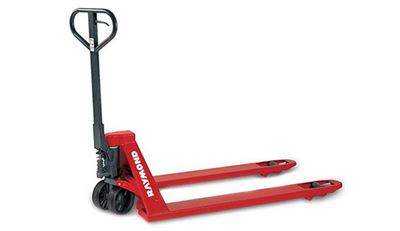Pallet Jacks | Santa Barbara

Raymond West is a Santa Barbara supplier of new and used electric and manual pallet jacks.
We are backed by one of the largest service and parts operations in Southern California.
Call us today at (805) 749-2777
When considering the acquisition of pallet jacks, it's important to evaluate the benefits and a few of the disadvantages of assorted types of pallet equipment.
Clearly, the principal function of a pallet truck is to propel pallets around a storage facility, manufacturing facility or other enterprise where pallets will need to be toted.
However, based on the size of your location, the tonnage of pallets that will be positioned, the consistency of utilization, and other factors, you may want to get a deeper knowledge of which pallet trucks perform best in which environments.
The following article is a synopsis of pallet truck classifications, attributes, restrictions and use scenarios.
Hand Pallet Jacks
Manual pallet trucks have been in existence since 1918 and have never changed much since that time. They are made up of a steel chassis, a fork and a hydraulic component that's activated by pumping the handle up and down.
The operator of a manual pallet truck positions the forks underneath the pallet, boosts the pallet away from the ground and wheels the pallet to a secondary place, guiding the equipment with the tiller.
Situations where lift elevation is not crucial may possibly be a good use for a non-powered pallet jack, including grocery store aisles, warehouse short runs and similar. As opposed to a lift truck, manual jacks are also somewhat portable and will fit in the back of a truck or cargo van for deliveries. The load capacity of the majority of hand pallet trucks is around 5500 lbs.
Manual pallet trucks are perfect for infrequent use scenarios across limited stretches. Manual units are not the most suitable choice for transferring loads over more lengthy distances, inclines or rough terrain. Users must manually maneuver the equipment which is quite often physically draining after a period of time.
Walkie Pallet Jacks
Although about twice the size of non-powered pallet jacks, walkies are still relatively small in size and they're highly maneuverable.
Walkie pallet jacks are powered by on-board battery packs. The battery supplies a powered assist for propelling and lifting the forks. The user no longer must activate the tiller to lift the pallet, nor do they have to manually propel the pallet along through the warehouse.
Nonetheless, they are still called "walkies", given that the driver does still have to walk at the rear of or beside them.
A walkie pallet truck's max speed is lower as compared to rider jacks, because the operator needs to keep up with the equipment instead of riding on it. This is in reality somewhat of an unintentional "safety feature", since restricted speeds also lessen the significance of collisions.
The maximum capacity of many walkie pallet trucks is between 4500-6000 lbs.
Even though they're more accommodating than hand pallet jacks, walkies must be recharged consistently, considering that they're battery powered. In addition, walkies call for more service than hand pallet trucks because there are more moving parts and points of potential electrical issues.
The primary uses for walkie pallet trucks are dock plates, trailers and short to middle distance runs.
Rider Pallet Jacks
Rider pallet jacks are like walkies, although they have a standing platform for the driver. There are very few controls on rider pallet trucks so they are relatively simple to maneuver and necessitate minimal training.
Operators can step on the platform instead of just walking behind or beside the pallet truck. This means that rider jacks are a more efficient solution for advancing pallets across lengthier distances versus walkie or hand pallet jacks. They're ideal for constant movement over longer spans and they're used quite a bit in large distribution centers and manufacturing facilities.
The driver platform is suitable for short distances, but not optimal for operators that handle them throughout the day because they're relatively minimal and cause the controller to stand in a sideways stance.
Rider jacks are larger than walkie or manual pallet jacks, so impacts can result in fairly significant personal injury and property destruction. Rider pallet trucks provide little defense for the operator vs other choices such as center riders.
Center Riders
Center riders are reminiscent of rider pallet jacks, but they are safer for the controller and allow a more ergonomic ride. The operator can stand fully to the front or to the back rather than only sideways.
Additionally, there is less hazard for the user, considering they're insulated by the machine chassis on two sides, although they're still subjected to the somewhat unlikely risk of the lifting mechanism.
Center riders are less maneuverable than rider pallet trucks and they are frequently employed for applications where the user drives typically in a direct path.
Center riders are quite often put to work in general factory operations, warehouse and beverage uses.
Where To Rent Or Buy Pallet Trucks In Santa Barbara, California
If you’d like to speak with a Raymond representative about pallet jacks, please get in touch with Raymond West, a Santa Barbara material handling equipment supplier serving all of Santa Barbara County, including: Buellton, Carpinteria, Goleta, Lompoc, Santa Barbara and Santa Maria.
Raymond West
3905 State St
Santa Barbara, CA 93105
(805) 749-2777
7:00 AM - 5:00 PM
Monday - Friday

